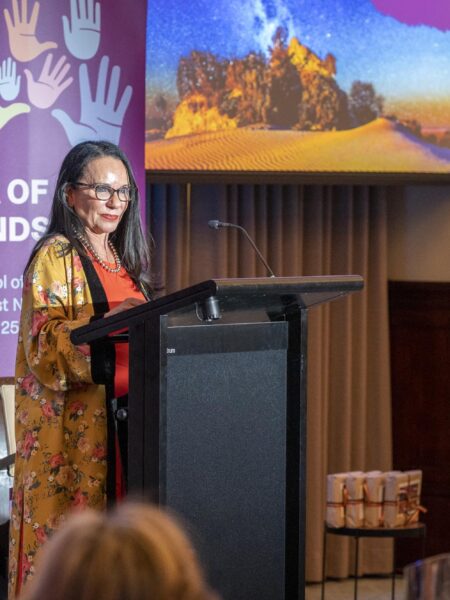No treaty was signed at first contact or in the early years of settlement with the hundreds of Aboriginal and Torres Strait Islander communities who had cared for country for over 60,000 years. At Federation, Indigenous peoples were again ignored. Australia was built on the exclusion of Aboriginal and Torres Strait Islander peoples.
Indigenous Australians have long called for this deficit to be remedied. Most recently, in the Uluru Statement from the Heart, Aboriginal and Torres Strait Islander peoples renewed their demand for treaty. The Statement calls for a First Nations Voice to be put in the Constitution, and a Makarrata Commission to be established by law to supervise a process of agreement making and truth telling.
The federal government has dismissed these calls. However, over the last four years, Victoria, Queensland, and the Northern Territory have started a process to talk treaty. These are significant steps. Yet, because there is no shared language or history of treaty-making in Australia, many challenges exist.
One challenge revolves around the concept of treaty. Many Australians do not know what a treaty is or could involve. In a new edition of Treaty, George Williams (Dean UNSW Law) and I answer this question and explore other major issues surrounding Indigenous-State treaty-making, with the aim of demystifying this concept. In this short extract, we answer that first question.
What is a treaty
A treaty must be consistent with international law and contemporary legal values. Simply calling an agreement a treaty does not make it so. Based on the modern comprehensive agreements negotiated in Canada, and the United Nations Declaration on the Rights of Indigenous Peoples, we argue that a treaty is a special agreement that must meet three elements.
Recognition as polities
A precondition to treaty negotiations is acknowledgment of the reality that Indigenous peoples were prior owners and occupiers of the land now claimed by the State. This is an important condition but alone is insufficient to satisfy the first element. A treaty must also recognise the Indigenous people as a polity.
A polity is a distinct political community composed of individuals collectively united by identity. It can take many forms, including a nation-State, empire, or a sub-State unit. Indigenous communities in Australia have a long history of operating as a distinct society, with unique economic, religious and spiritual relationships to their land. Despite this, governments have often preferred to conceive of Indigenous peoples as cultural or ethnic minority groups within the larger Australian community.
An important function of a treaty is to redress this by way of appropriate acknowledgement. As Kurnai/Gunai, Gunditjmara, Wiradjuri and Yorta Yorta writer Nayuka Gorrie explains, ‘a treaty forces you to see me as an equal, with a separate identity, history and culture that has existed for tens of thousands of years’. Palawa lawyer and activist Michael Mansell agrees, noting:
Practically all calls for a treaty with Aboriginals urge a re-definition of the political relationship between Aboriginals and Australia….Implicit in this call is the assertion that Aboriginals are not just a section of Australian society, but a people with a distinct political status – not one subordinate to Australian governments, but in some respects, equal to them (at p 140).
The High Court has recognised that important legal consequences result from Indigenous communities being distinct polities. In 2020 in Love v Commonwealth the Court found that because of the deep connection to country that Aboriginal people have, an Aboriginal person who is not a citizen of Australia cannot be considered an ‘alien’ for the purpose of the Constitution (at [74]).
Reached by negotiation
If the starting point in a treaty relationship is acknowledgment, then the preferred process for moving forward is negotiation. Negotiation is, of course, not just consultation. ‘Consultation’ is something governments have been doing in Indigenous affairs in Australia for years and is driven by the agency seeking Indigenous involvement in the development, endorsement or implementation of a plan or program. Negotiation is where parties sit around the table, agree on an agenda and work their way towards agreement. Consultation is one-way; negotiation is two-way.
There are many reasons – pragmatic reasons as well as ones of principle – for entrenching negotiation as the process of first resort in Indigenous affairs. Negotiation reduces the risk that the rights and interests of any significant group will be ignored. It brings relevant information and perspectives to the decision-making process in a direct way. It recognises that winner-takes-all processes are unlikely to endure or produce good policy. It allows sophisticated, flexible and tailored solutions to be worked out by the parties with a direct interest in the outcome. It builds relationships based on trust and regular communication. In short, negotiation can improve the quality of outcomes.
Choosing negotiation is rational and efficient. It also reflects a basic ethic of fair dealing and respect for other points of view. By developing the capacity for managing co-existence in Australia, negotiation is a vital tool in the effort to achieve justice and reconciliation.
Settlement of claims
Many people see the process of entering into treaty discussions, of engaging in negotiation, as a virtue in itself because it can develop relationships, build trust and enhance knowledge, skills and perspectives on all sides. Indeed, preparing for treaty negotiations can also enable Indigenous peoples to engage in nation-(re)building, consistent with their values and aspirations, which is valuable regardless of the content, or even the completion, of a treaty. Nonetheless, negotiations will demand a lot of time, effort and goodwill. The negotiators, the constituencies they represent and indeed the whole country will want to see substantive outcomes.
One of the key goals of any treaty is a just settlement of claims. Both sides must accept a series of responsibilities so that the agreement can bind the parties in a relationship of mutual obligation. This goes beyond each party tolerating the other’s existence to accepting their enduring presence; accepting that, in the words of Chief Justice Lamer of the Supreme Court of Canada, ‘we are all here to stay’ (at [186]).
One outcome is important, however. A treaty must recognise that the Indigenous signatories have an inherent right to exercise some form of self-government.
Recognising a right to self-government is important as it indicates that the purpose of a treaty is more than an act of symbolic recognition. It is recognition of a relationship between Indigenous peoples and the State designed to improve the lives of Indigenous communities, and to secure the foundations for a just partnership. By embedding rights to self-government and exploring the possibility for greater regional autonomy and other governance options, treaty making also has the potential to deliver outcomes to Indigenous communities in the form of opportunities as well as rights.
Conclusion
Starting many of these conversations 230 years after first contact makes treaty negotiation more difficult. It does not make those negotiations impossible. The essence of a treaty is consent and agreement. Ultimately Aboriginal peoples, Torres Strait Islanders and non-Indigenous Australians need to be convinced that there is a pragmatic and principled case for treaty-making. If they agree, treaty processes around Australia are likely to succeed.
Treaty (2nd Ed) by George Williams and Harry Hobbs is available from our shop.




